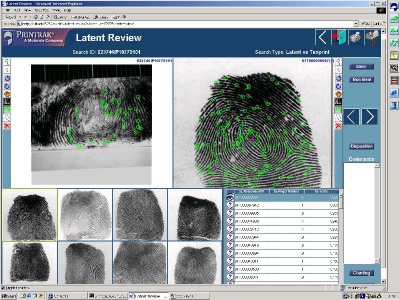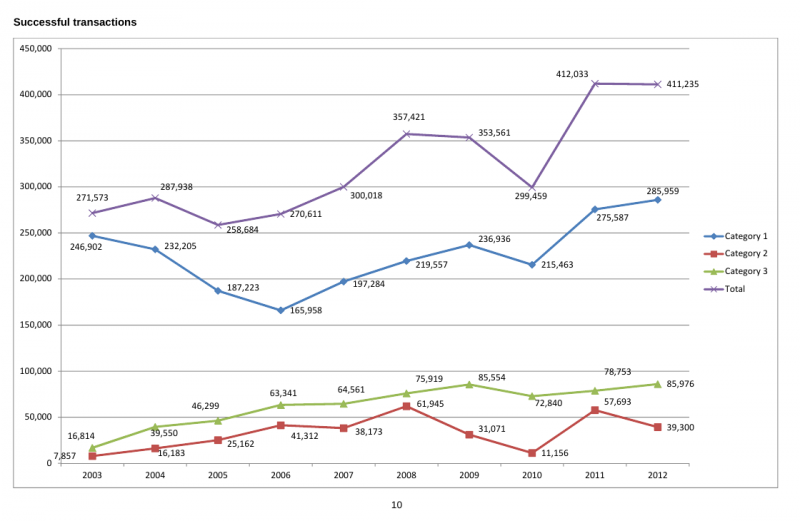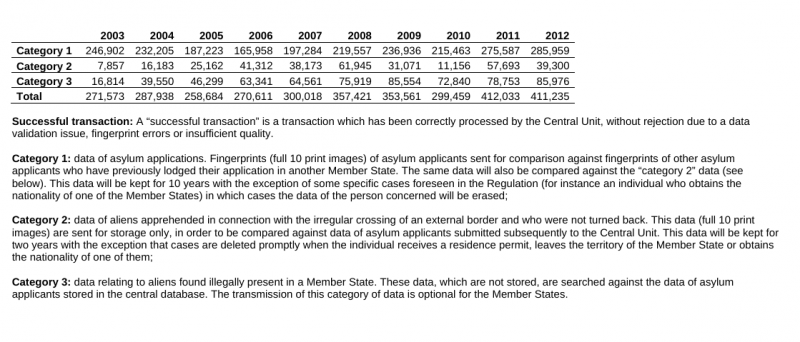Eurodac (BD2015): Unterschied zwischen den Versionen
Anna (Diskussion | Beiträge) K (content) |
Anna (Diskussion | Beiträge) K (corr.) |
||
| (11 dazwischenliegende Versionen desselben Benutzers werden nicht angezeigt) | |||
| Zeile 1: | Zeile 1: | ||
| − | <p style="text-align: center"></p><p style="text-align: center">'''Europäische Volksparteien im Europaparlament: [http://www.eppgroup.eu/press-release/Security-for-Europeans,-safety-for-asylum-protection-holders http://www.eppgroup.eu/press-release/Security-for-Europeans,-safety-for-asylum-protection-holders]'''</p><p style="text-align: center"></p><p style="text-align: center"></p><p style="text-align: center">[[File:Afis1.jpg|400px|Afis1.jpg]] [[File:Epp-eurodac.png|400px|Epp-eurodac.png]]</p><p style="text-align: center"></p> | + | |
| + | <div align="center"> | ||
| + | <mediaplayer image='http://philo.at/videos/epp-preview.png'>http://philo.at/videos/Security_for_Europeans,_safety_for_asylum_protection_holders.mp4</mediaplayer> | ||
| + | </div> | ||
| + | |||
| + | <p style="text-align: center"></p><p style="text-align: center">'''Europäische Volksparteien im Europaparlament: [http://www.eppgroup.eu/press-release/Security-for-Europeans,-safety-for-asylum-protection-holders http://www.eppgroup.eu/press-release/Security-for-Europeans,-safety-for-asylum-protection-holders]'''</p><br/><p style="text-align: center"></p><p style="text-align: center"></p><p style="text-align: center">[[File:Afis1.jpg|400px|Afis1.jpg]] [[File:Epp-eurodac.png|400px|Epp-eurodac.png]]</p><p style="text-align: center"></p> | ||
| + | |||
| + | <br /> | ||
| + | Monica Lousia Macovai erklärt die drei Daten-Kategorien in Eurodac. Sie zählt sie der Reihe nach auf und nennt dabei die Kategorie 3 an zweiter Stelle. Die Handhabung der Kategorien und ihre Bedeutung ist wie folgt: | ||
| + | |||
| + | #Die Eingabe eines Fingerabdrucks eines Asylsuchenden wird mit vorhandenen Fingerabdrücken von Asylsuchenden verglichen. Ein Treffer heißt, dass diese Person bereits einen Asylantrag gestellt hat. (Im Land, das den Abdruck prüfen lässt, oder in einem anderen Schengenland.) | ||
| + | #Darauf wird überprüft, ob die Abdrücke eines Asylsuchenden bereits als Abdrücke einer Person erfasst sind, welche die Schengengrenze unberechtigt überschritten hat. In diesem Fall wäre das Land des Grenzübertrittes für das Asylverfahren verantwortlich. | ||
| + | #Schließlich wird geprüft, ob es sich um Fingerabdrücke eines Asylsuchenden handelt, der sich unberechtigt im Land der Datenabfrage aufhält. Diese Prüfung ist fakultativ. | ||
| + | |||
| + | Diese Konstruktion führt dazu, dass in den Ländern der Erstaufnahme kein besonderes Interesse daran besteht, Asylsuchende als solche oder - vor allem - unberechtigte Ankömmlinge, zu registrieren. Die Dublin-Regeln besagen ja, dass für alle im Schengenraum angetroffenen Asylsuchenden das Land der Erstaufnahme zuständig ist. | ||
| + | |||
| + | <br /> | ||
| + | '''[http://wirtschaftsblatt.at/home/nachrichten/europa_cee/1439017/EU-sichert-heikle-Daten-weiterhin-in-St-Johann Österreichbezug]''' | ||
| + | <br /> | ||
'''Übersicht: [http://www.statewatch.org/analyses/no-235-eurodac.pdf Chris Jones: Analysis 11 Years of Eurodac], [http://www.euractiv.com/sections/justice-home-affairs/eurodac-fingerprint-database-under-fire-human-rights-activists-316311 Problembericht]''' | '''Übersicht: [http://www.statewatch.org/analyses/no-235-eurodac.pdf Chris Jones: Analysis 11 Years of Eurodac], [http://www.euractiv.com/sections/justice-home-affairs/eurodac-fingerprint-database-under-fire-human-rights-activists-316311 Problembericht]''' | ||
| Zeile 5: | Zeile 23: | ||
[[File:Jones1.png|800px|Jones1.png]] | [[File:Jones1.png|800px|Jones1.png]] | ||
<p style="text-align: center">[[File:Jones2.png|800px|Jones2.png]]</p> | <p style="text-align: center">[[File:Jones2.png|800px|Jones2.png]]</p> | ||
| − | |||
'''Wiki Artikel''' | '''Wiki Artikel''' | ||
| Zeile 57: | Zeile 74: | ||
| − | '''Exzerpte | + | '''Exzerpte. Jonathan P. Aus: Eurodac: A Solution Looking for a Problem? Working Paper No. 09, May 2006. [https://www.sv.uio.no/arena/english/research/publications/arena-publications/workingpapers/working-papers2006/wp06_09.pdf [1]]''' |
| + | |||
| + | '''S. 22''' | ||
| + | |||
| + | In the end, the German Presidency had not only achieved that every Member State ''must'' systematically fingerprint ''irregular border-crossers'' (in addition to ''asylum applicants''). It had also accomplished that national authorities ''may'' take the fingerprints of ''illegally resident'' third country nationals in order to check whether the templates of this person might match with an entry in the Eurodac database. | ||
| + | |||
| + | '''S.29 ff''' | ||
| − | '''S. 32ff''' The past and present actor constellation and mode of executive interaction concerning Eurodac represent, game-theoretically speaking, a Rambo-situation. The political dynamics of such a situation may best be illustrated by shedding light on the patterns of inter-state conflict over the river Rhine. | + | <font color="purple">Eurodac’s performance in regard to irregular border-crossers, on the other hand, i.e. the category of people covered by the former Eurodac Protocol, is a near complete failure.</font> At closer inspection of the data released to the public by the European Commission, one is struck by the very small amount of Eurodac entries relating to irregular border-crossers. The Commission had estimated to receive approximately 400,000 fingerprint templates of apprehended irregular bordercrossers per year from the Member States. In actual fact, however, it merely received an average of about 12,000 fingerprint sets per annum. The overwhelming majority (82%) of fingerprint data in this category were transmitted by Greece, Italy, and Spain. What is interesting about these figures is not the relatively high share, but the very low volume of data transmitted to the Central Unit by Greece, Italy, and Spain. The patterns of intergovernmental conflict highlighted in section 3.2 above have evidently been resurfacing in the form of deliberate non-compliance with Community law. |
| + | |||
| + | Underpinning the sense of premeditated non-compliance with EC law on the part of external border countries in Southern Europe, both the Greek and Italian authorities made sure that the few data they did transmit to the Central Unit were sent so late that other Member States’ queries in the database would yield negative results. In 2004, for example, the Greek authorities waited on average more than 29 days before actually transmitting the fingerprints of an apprehended irregular border-crosser to the Central Unit. This gave the would-be refugee in question approximately four weeks to lodge a potentially successful application for asylum in another Member State – after having been fingerprinted for illegal border-crossing in Greece. On the basis of the available data, we may infer that a large proportion of third country nationals illegally entering EU territory in Greece and Italy subsequently lodge asylum applications in the UK, | ||
| + | |||
| + | '''S. 32ff''' | ||
| + | |||
| + | The past and present actor constellation and mode of executive interaction concerning Eurodac represent, game-theoretically speaking, a Rambo-situation. The political dynamics of such a situation may best be illustrated by shedding light on the patterns of inter-state conflict over the river Rhine. | ||
... | ... | ||
| Zeile 76: | Zeile 105: | ||
The appropriate thing to do in a situation like this was to call for the compulsory fingerprinting of "illegal" immigrants and for the storage of their biometric data in a central European database. Against this empirical background, one may conclude that Eurodac is first and foremost an expression of a police-specific behavioral logic. <font color="purple">What is surprising about Eurodac from an Institutionalist perspective is not its particular conception of appropriateness, but rather the remarkable absence of empirically observable collisions with competing and contradictory sets of institutionalized rules.</font> After all, "major political conflicts are focused on which set of rules should prevail when and where." The only political conflicts we have witnessed in the context of the negotiation of the Eurodac Regulations, namely the intergovernmental conflict over the redistribution of asylum applicants "through the backdoor," on the one hand, and the power struggle between the Council and the Commission over implementing rules, on the other, did not fundamentally challenge Eurodac’s police-specific rationale. The apparent lack of concern inter alia for the privacy rights of third country nationals may be accounted for, however, by the particular institutional design of the intergovernmental Schengen regime, the so-called "Third Pillar" of the European Union during the "Maastricht" era, and the Community governance of external borders, asylum, and international migration following the entry into force of the Treaty of Amsterdam. | The appropriate thing to do in a situation like this was to call for the compulsory fingerprinting of "illegal" immigrants and for the storage of their biometric data in a central European database. Against this empirical background, one may conclude that Eurodac is first and foremost an expression of a police-specific behavioral logic. <font color="purple">What is surprising about Eurodac from an Institutionalist perspective is not its particular conception of appropriateness, but rather the remarkable absence of empirically observable collisions with competing and contradictory sets of institutionalized rules.</font> After all, "major political conflicts are focused on which set of rules should prevail when and where." The only political conflicts we have witnessed in the context of the negotiation of the Eurodac Regulations, namely the intergovernmental conflict over the redistribution of asylum applicants "through the backdoor," on the one hand, and the power struggle between the Council and the Commission over implementing rules, on the other, did not fundamentally challenge Eurodac’s police-specific rationale. The apparent lack of concern inter alia for the privacy rights of third country nationals may be accounted for, however, by the particular institutional design of the intergovernmental Schengen regime, the so-called "Third Pillar" of the European Union during the "Maastricht" era, and the Community governance of external borders, asylum, and international migration following the entry into force of the Treaty of Amsterdam. | ||
| + | |||
| + | |||
| + | |||
| + | |||
| + | |||
[[Category:Big Data. WS 2015]] | [[Category:Big Data. WS 2015]] | ||
Aktuelle Version vom 29. Oktober 2015, 12:46 Uhr
<mediaplayer image='http://philo.at/videos/epp-preview.png'>http://philo.at/videos/Security_for_Europeans,_safety_for_asylum_protection_holders.mp4</mediaplayer>
Europäische Volksparteien im Europaparlament: http://www.eppgroup.eu/press-release/Security-for-Europeans,-safety-for-asylum-protection-holders
Monica Lousia Macovai erklärt die drei Daten-Kategorien in Eurodac. Sie zählt sie der Reihe nach auf und nennt dabei die Kategorie 3 an zweiter Stelle. Die Handhabung der Kategorien und ihre Bedeutung ist wie folgt:
- Die Eingabe eines Fingerabdrucks eines Asylsuchenden wird mit vorhandenen Fingerabdrücken von Asylsuchenden verglichen. Ein Treffer heißt, dass diese Person bereits einen Asylantrag gestellt hat. (Im Land, das den Abdruck prüfen lässt, oder in einem anderen Schengenland.)
- Darauf wird überprüft, ob die Abdrücke eines Asylsuchenden bereits als Abdrücke einer Person erfasst sind, welche die Schengengrenze unberechtigt überschritten hat. In diesem Fall wäre das Land des Grenzübertrittes für das Asylverfahren verantwortlich.
- Schließlich wird geprüft, ob es sich um Fingerabdrücke eines Asylsuchenden handelt, der sich unberechtigt im Land der Datenabfrage aufhält. Diese Prüfung ist fakultativ.
Diese Konstruktion führt dazu, dass in den Ländern der Erstaufnahme kein besonderes Interesse daran besteht, Asylsuchende als solche oder - vor allem - unberechtigte Ankömmlinge, zu registrieren. Die Dublin-Regeln besagen ja, dass für alle im Schengenraum angetroffenen Asylsuchenden das Land der Erstaufnahme zuständig ist.
Übersicht: Chris Jones: Analysis 11 Years of Eurodac, Problembericht
Wiki Artikel
Exzerpte aus: Stephen Kabera Karanja: Transparency and Proportionality in the Schengen Information System and Border Control Co-operation. Leiden, Boston 2008
S. 27ff:
According to the Regulation, each Member State is required, in compliance to its national law and practice, to take the fingerprints of every non-EU or third country national aged 14 years or over who applies for asylum. All EU Member States have in place automated fingerprinting systems for asylum seekers. As a result of the Eurodac Regulation, Member States have put in place computerised systems capable of transmitting “images” of asylum seekers’ fingerprints. The procedure for taking the fingerprints is governed by national law but the applicant for asylum must be informed the purpose of taking the fingerprints as provided in Article 13(1) of the Eurodac Convention.
Data transmitted to the central database is classified according to the three categories of persons to be registered. The three categories are:
- asylum seekers Article 5 (category 1),
- persons irregular crossing of an external border, Article 8 (category 2) and
- persons found illegally present in a Member State, Article 11 (category 3).
Once fingerprints from the three categories are transmitted by the Member State to the Central Unit, the Central Unit records the data in the central database. The Central Unit then compares the data so transmitted by the Member State with the fingerprints transmitted by other Member States recorded in the central database. It first compares Category 1 against Category 1 and if a hit is returned, it means that the fingerprints of an asylum seeker have been recognised by the Central Unit as a match against the stored fingerprints of an existing asylum applicant. This hit is referred to as ‘local’ when the asylum seeker has already applied for asylum in the same Member States and ‘foreign’ when he/she has already applied for asylum in another state. Then it compares Category 1 against Category 2 and if a hit is returned, it means that the fingerprints of an asylum seeker match the stored fingerprints of an alien who has illegally crossed the border and who could not be turned back. Finally, the Central Unit compares Category 3 against Category 1 data and if a hit is returned, it means that the fingerprints of an alien found illegally present within a Member State are being recognised by the Central Unit as a match against the stored fingerprints of an asylum seeker.
Only data transmitted under Articles 5 and 8 are to be recorded in the central database. Data transmitted under Article 11 are to be erased and the transmission media destroyed once the results of the comparison have been transmitted to the Member State of origin.
Article 5 of the Regulation deals with the data for asylum seekers recorded in the central database. The data include:
- the Member State of origin, place and data of the application for asylum;
- the fingerprints data;
- sex;
- reference number used by the Member State of origin, and;
- date on which the fingerprints were taken.
- Other data are:
- the date on which the data was transmitted to the Central Unit;
- date on which the data were entered in the central database, and;
- details in respect of the recipient(s) of the data transmitted and the date(s) of transmission(s).
Article 8 deals with data for persons apprehended in connection with the irregular crossing of an external border. The data are similar to the first set of data in Article 5 above. After the data have been entered in the central database and the comparison is complete, the transmission media is to be destroyed or returned to the Member States of origin if so requested after the recording of the data in the central unit. Clearly some objective data such as the name and nationality of the asylum applicant are omitted because the purpose of the Eurodac system is to compare fingerprints and not to identify the applicant. Identification of the applicant is the responsibility of the Member State of origin in co-operation with the Member States concerned.
it is the responsibility of the Member State of origin to make the final identification of data pursuant to Article 4(6). That is, the making of identification of data after the comparison of fingerprints data by the Central Unit. Placing this obligation on the Member State is important because the Central Unit does not make any matching or linking of data to an individual. This obligation is left to the Member State of origin who has the data linking an individual to a set of fingerprints.
Exzerpte. Jonathan P. Aus: Eurodac: A Solution Looking for a Problem? Working Paper No. 09, May 2006. [1]
S. 22
In the end, the German Presidency had not only achieved that every Member State must systematically fingerprint irregular border-crossers (in addition to asylum applicants). It had also accomplished that national authorities may take the fingerprints of illegally resident third country nationals in order to check whether the templates of this person might match with an entry in the Eurodac database.
S.29 ff
Eurodac’s performance in regard to irregular border-crossers, on the other hand, i.e. the category of people covered by the former Eurodac Protocol, is a near complete failure. At closer inspection of the data released to the public by the European Commission, one is struck by the very small amount of Eurodac entries relating to irregular border-crossers. The Commission had estimated to receive approximately 400,000 fingerprint templates of apprehended irregular bordercrossers per year from the Member States. In actual fact, however, it merely received an average of about 12,000 fingerprint sets per annum. The overwhelming majority (82%) of fingerprint data in this category were transmitted by Greece, Italy, and Spain. What is interesting about these figures is not the relatively high share, but the very low volume of data transmitted to the Central Unit by Greece, Italy, and Spain. The patterns of intergovernmental conflict highlighted in section 3.2 above have evidently been resurfacing in the form of deliberate non-compliance with Community law.
Underpinning the sense of premeditated non-compliance with EC law on the part of external border countries in Southern Europe, both the Greek and Italian authorities made sure that the few data they did transmit to the Central Unit were sent so late that other Member States’ queries in the database would yield negative results. In 2004, for example, the Greek authorities waited on average more than 29 days before actually transmitting the fingerprints of an apprehended irregular border-crosser to the Central Unit. This gave the would-be refugee in question approximately four weeks to lodge a potentially successful application for asylum in another Member State – after having been fingerprinted for illegal border-crossing in Greece. On the basis of the available data, we may infer that a large proportion of third country nationals illegally entering EU territory in Greece and Italy subsequently lodge asylum applications in the UK,
S. 32ff
The past and present actor constellation and mode of executive interaction concerning Eurodac represent, game-theoretically speaking, a Rambo-situation. The political dynamics of such a situation may best be illustrated by shedding light on the patterns of inter-state conflict over the river Rhine.
...
As one may have expected, the “Rambos” at first showed no interest in a solution like Eurodac and were subsequently subjected to a strategy of Schengen-related “carrots” and “sticks.” The latter involved the temporary reinforcement of internal border controls, while the former entailed the prospect of their complete removal – provided that the entire Schengen acquis, including the systematic fingerprinting of irregular border-crossers, had been fully complied with.
...
Eurodac’s ongoing operational problems stem from the fact that cross-national compliance with new rules and procedures is very unlikely in Rambo-situations. This game-theoretic insight explains why Eurodac is a near complete failure in regard to irregular border-crossers. ... The unilateral political and administrative benefits of not being held responsible for processing the asylum requests of tens or even hundreds of thousands of irregular border-crossers each year are apparently valued higher than the costs of sustained non-compliance with Community law.
We have also learned that Eurodac is performing as efficiently as promised by its corporate suppliers in regard to ordinary asylum applicants. The Rationalist explanation for Eurodac’s partial success is that all Member States and associated third countries potentially benefit from conducting “one-to-many checks” in this category. What is at stake here is not the redistribution of asylum applicants from north to south or west to east, but rather the combating of “asylum abuse” in an integrating Europe striving for a full-fledged harmonization of substantive and procedural refugee law.
...
Dactyloscopy is the science of fingerprinting. Automated fingerprint identification systems like Eurodac are technologically advanced law enforcement tools. In contrast to human beings, these machines are able to compare hundreds of thousands of biometric datasets in a matter of seconds and achieve conviction rates of nearly 100%. But what, one may ask, does all of this have to do with the European Union in general and Community asylum policy in particular? The empirical answer to this question is that the operational success of automated fingerprint identification systems in the Member States motivated their establishment on European level. ... National governments and administrations experienced in operating large-scale biometric databases successfully managed to "upload" domestic standard operating procedures to the supranational level. The "bottom-up" process of applying ready-made national solutions to a new set of European problems involved a particular "framing" of the political challenge at hand. The empirical evidence accordingly suggests that resourceful actors like the German Ministry of the Interior perceived the refugee crisis of 1997-98 as a problem of organized crime.
The appropriate thing to do in a situation like this was to call for the compulsory fingerprinting of "illegal" immigrants and for the storage of their biometric data in a central European database. Against this empirical background, one may conclude that Eurodac is first and foremost an expression of a police-specific behavioral logic. What is surprising about Eurodac from an Institutionalist perspective is not its particular conception of appropriateness, but rather the remarkable absence of empirically observable collisions with competing and contradictory sets of institutionalized rules. After all, "major political conflicts are focused on which set of rules should prevail when and where." The only political conflicts we have witnessed in the context of the negotiation of the Eurodac Regulations, namely the intergovernmental conflict over the redistribution of asylum applicants "through the backdoor," on the one hand, and the power struggle between the Council and the Commission over implementing rules, on the other, did not fundamentally challenge Eurodac’s police-specific rationale. The apparent lack of concern inter alia for the privacy rights of third country nationals may be accounted for, however, by the particular institutional design of the intergovernmental Schengen regime, the so-called "Third Pillar" of the European Union during the "Maastricht" era, and the Community governance of external borders, asylum, and international migration following the entry into force of the Treaty of Amsterdam.



